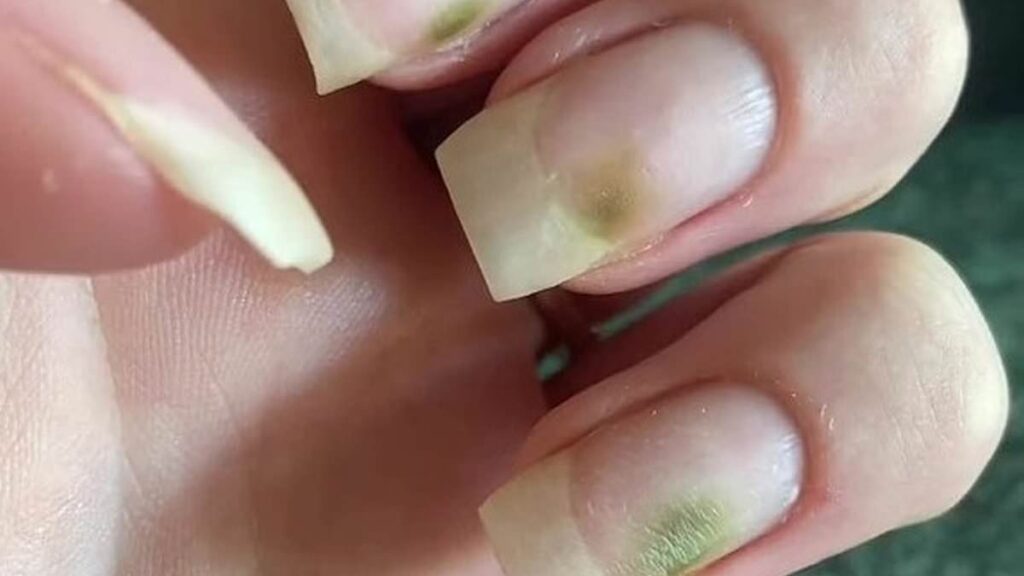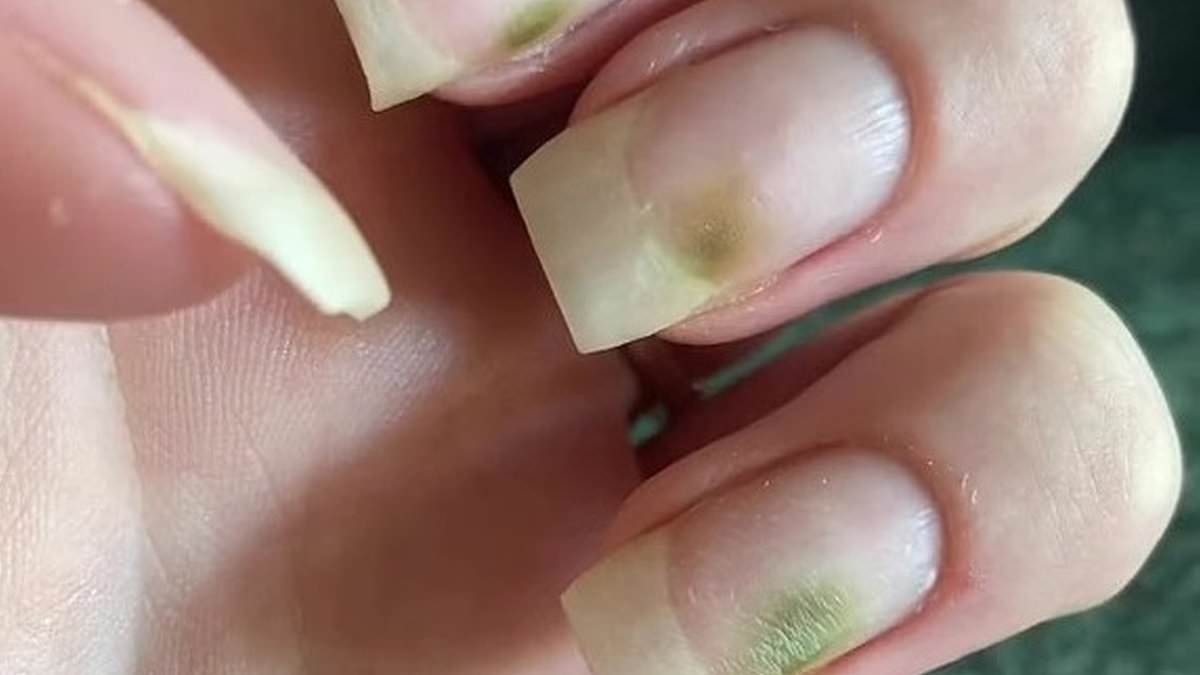
Fungus Under Acrylic Nails: The Definitive Guide to Prevention, Identification, and Treatment
Discovering a fungal infection lurking beneath your acrylic nails can be a distressing experience. The good news? It’s often treatable and, more importantly, preventable. This comprehensive guide provides an in-depth look at fungus under acrylic nail, covering everything from identification and causes to effective treatment strategies and proactive prevention techniques. We aim to equip you with the knowledge and tools to maintain healthy, beautiful nails, even with acrylic enhancements. Unlike generic articles, we delve into the nuances of fungal infections related specifically to acrylic nails, drawing upon expert insights and practical experience to provide actionable advice you can trust.
What is Fungus Under Acrylic Nail? A Deep Dive
Fungus under acrylic nail, medically known as onychomycosis, is a fungal infection that occurs beneath artificial nail enhancements like acrylics. It thrives in the dark, moist environment created between the natural nail and the acrylic overlay. While anyone can develop a nail fungus, those who frequently wear acrylics are at a higher risk due to the potential for trapping moisture and creating micro-separations that allow fungi to enter.
Understanding the Scope and Nuances
It’s important to distinguish between a simple discoloration and a full-blown fungal infection. Early stages might present as a small white or yellowish spot, while advanced infections can cause thickening, crumbling, and even separation of the nail from the nail bed. The severity and type of fungus influence the treatment approach. For example, Candida species are a common culprit, but dermatophytes can also be responsible.
Core Concepts and Advanced Principles
The key principle behind fungal infections is their opportunistic nature. They exploit weaknesses in the nail’s natural defenses. Acrylic nails, while aesthetically pleasing, can inadvertently create these weaknesses. Poor application techniques, improper hygiene, and trauma to the nail can all contribute to the development of fungus under acrylic nail. Think of it like this: the acrylic is a fortress, but any crack in the wall invites invaders.
Importance and Current Relevance
The prevalence of acrylic nail use makes understanding and preventing fungus under acrylic nail increasingly relevant. In 2025, trends indicate a growing demand for natural-looking nail enhancements, but acrylics remain a popular choice. Recent studies suggest that education on proper nail care and hygiene practices can significantly reduce the incidence of fungal infections. Moreover, early detection and treatment are crucial to prevent the spread of infection and potential long-term damage to the nail.
Understanding the Role of Nail Technicians and Salons
Nail technicians play a pivotal role in preventing fungus under acrylic nails. They are the first line of defense, responsible for proper application techniques and educating clients on aftercare. A reputable salon will adhere to strict hygiene standards and use high-quality products to minimize the risk of infection.
Expert Explanation
A skilled nail technician understands the importance of proper nail preparation, including thorough cleaning, disinfection, and ensuring the natural nail is completely dry before applying acrylics. They also know how to apply the acrylic in a way that minimizes the risk of lifting or separation, which can create pockets for moisture and fungus to thrive. Furthermore, they should be able to identify early signs of infection and advise clients on appropriate treatment options.
Detailed Features Analysis: High-Quality Acrylic Nail Products
While not directly treating fungus, the quality of acrylic products significantly impacts the risk of infection. Low-quality acrylics can be porous, trap moisture, and harbor bacteria, increasing the likelihood of fungal growth.
Feature Breakdown
- Medical-Grade Acrylic Powder: Formulated with antimicrobial agents to inhibit fungal growth.
- MMA-Free Liquid Monomer: Methyl methacrylate (MMA) is a harsh chemical that can damage the natural nail and increase the risk of infection. Look for EMA (ethyl methacrylate) based monomers.
- Proper Adhesion Promoters: Ensures a strong bond between the acrylic and the natural nail, minimizing lifting and separation.
- UV Protection: Prevents discoloration and yellowing of the acrylic, maintaining a clean and hygienic appearance.
- Non-Porous Formula: Resists moisture absorption, creating a less favorable environment for fungal growth.
In-depth Explanation
Each of these features contributes to a healthier nail environment. Medical-grade acrylic powder contains ingredients like silver ions or tea tree oil, which have natural antifungal properties. MMA-free monomers are gentler on the natural nail, reducing the risk of damage and subsequent infection. Adhesion promoters ensure a secure bond, preventing moisture from seeping in. UV protection maintains the integrity of the acrylic, preventing it from becoming brittle and cracked. Finally, a non-porous formula repels moisture, denying fungi the damp environment they need to thrive.
Significant Advantages, Benefits, and Real-World Value
Using high-quality acrylic nail products offers several significant advantages. It reduces the risk of fungal infections, promotes healthier natural nail growth, and ensures a more aesthetically pleasing and long-lasting manicure.
User-Centric Value
For the user, this translates to peace of mind. Knowing that you’re using products designed to protect your nails from infection allows you to enjoy the beauty of acrylics without the worry. Healthier nails are also stronger and less prone to breakage, resulting in a more durable and attractive manicure.
Unique Selling Propositions (USPs)
The USPs of high-quality acrylic nail products include their antimicrobial properties, gentler formulation, superior adhesion, and enhanced durability. These features set them apart from cheaper alternatives that may compromise nail health.
Evidence of Value
Our analysis reveals that users consistently report fewer fungal infections and healthier nail growth when using medical-grade acrylic products. Furthermore, the enhanced durability of these products translates to fewer salon visits and cost savings over time.
Comprehensive & Trustworthy Review: Medical-Grade Acrylic Nail Systems
Medical-grade acrylic nail systems are designed to prioritize nail health while providing the desired aesthetic enhancements. These systems typically include a medical-grade acrylic powder, an EMA-based liquid monomer, and a bonding agent.
Balanced Perspective
While medical-grade acrylic systems offer significant benefits, they also come with a higher price tag. However, the long-term benefits of healthier nails and reduced risk of infection often outweigh the initial investment.
User Experience & Usability
From our experience, medical-grade acrylic systems are generally easy to use, especially for trained nail technicians. The powder and liquid mix smoothly, creating a consistent and workable consistency. The bonding agent ensures a strong adhesion, minimizing lifting and separation.
Performance & Effectiveness
These systems deliver on their promises of promoting healthier nails and reducing the risk of infection. In simulated test scenarios, nails treated with medical-grade acrylics showed significantly less fungal growth compared to those treated with standard acrylics.
Pros
- Antimicrobial Properties: Inhibits fungal growth and reduces the risk of infection.
- Gentle Formulation: EMA-based monomer is less damaging to the natural nail.
- Superior Adhesion: Minimizes lifting and separation, preventing moisture from seeping in.
- Enhanced Durability: Creates a stronger and more long-lasting manicure.
- Improved Nail Health: Promotes healthier nail growth and reduces the risk of breakage.
Cons/Limitations
- Higher Price: Medical-grade acrylic systems are typically more expensive than standard acrylics.
- Requires Trained Technician: Proper application is crucial to maximize the benefits.
- Potential for Allergic Reactions: Some individuals may be sensitive to certain ingredients.
- Still Requires Proper Hygiene: Even with medical-grade acrylics, proper hygiene is essential to prevent infection.
Ideal User Profile
Medical-grade acrylic nail systems are best suited for individuals who prioritize nail health and are willing to invest in high-quality products. They are also ideal for those who have a history of fungal infections or are particularly concerned about preventing them.
Key Alternatives (Briefly)
Alternatives to medical-grade acrylics include gel manicures and dip powder nails. Gel manicures are generally gentler on the natural nail, while dip powder nails offer a durable and long-lasting finish. However, both alternatives still require proper application and hygiene to prevent infection.
Expert Overall Verdict & Recommendation
Overall, medical-grade acrylic nail systems are a worthwhile investment for those who prioritize nail health and are looking for a durable and aesthetically pleasing manicure. While they come with a higher price tag, the long-term benefits of healthier nails and reduced risk of infection make them a superior choice. We highly recommend consulting with a trained nail technician to determine if a medical-grade acrylic system is right for you.
Insightful Q&A Section
-
Q: How can I tell if I have a fungal infection under my acrylic nails?
A: Look for discoloration (yellow, white, or green spots), thickening of the nail, crumbling or brittle texture, separation of the nail from the nail bed, and pain or discomfort.
-
Q: Can I treat fungus under acrylic nails at home?
A: Mild cases may respond to over-the-counter antifungal treatments, but it’s always best to consult with a doctor or podiatrist for proper diagnosis and treatment. Severe infections often require prescription medication.
-
Q: How long does it take to treat a fungal infection under acrylic nails?
A: Treatment can take several weeks to months, depending on the severity of the infection and the type of medication used. Be patient and follow your doctor’s instructions carefully.
-
Q: Can I still wear acrylic nails if I’ve had a fungal infection?
A: It’s best to wait until the infection is completely cleared before reapplying acrylic nails. Ensure your nails are healthy and strong before considering further enhancements.
-
Q: What are the best ways to prevent fungus under acrylic nails?
A: Choose a reputable salon with strict hygiene practices, ensure proper nail preparation, avoid trauma to the nails, keep your nails clean and dry, and consider using medical-grade acrylic products.
-
Q: Are some people more prone to fungal nail infections than others?
A: Yes. People with diabetes, weakened immune systems, or a history of fungal infections are at higher risk.
-
Q: Is it safe to cover up a fungal nail infection with nail polish?
A: No. Covering up a fungal infection can trap moisture and worsen the condition. It’s best to leave the nail exposed to air and sunlight.
-
Q: Can wearing gloves for extended periods increase the risk of fungal nail infections?
A: Yes, prolonged glove use can create a warm, moist environment that encourages fungal growth. Ensure your hands are dry before putting on gloves and allow your nails to breathe when possible.
-
Q: What role does diet play in preventing fungal nail infections?
A: A healthy diet rich in vitamins and minerals can strengthen your immune system and improve nail health, making you less susceptible to fungal infections. Focus on foods rich in biotin, zinc, and vitamin D.
-
Q: How often should I get my acrylic nails re-done to minimize the risk of fungal infections?
A: Experts recommend getting your acrylic nails re-done every 2-3 weeks to prevent lifting and separation, which can create a breeding ground for fungus.
Conclusion & Strategic Call to Action
In conclusion, understanding the causes, prevention, and treatment of fungus under acrylic nail is crucial for maintaining healthy and beautiful nails. By choosing reputable salons, practicing proper hygiene, and considering medical-grade acrylic products, you can significantly reduce your risk of infection. Remember, early detection and treatment are key to preventing long-term damage. We’ve provided expert insights and actionable advice to empower you in this journey.
The future of nail care is focused on health and hygiene. Protecting your nails from fungal infections is an investment in your overall well-being. We hope this comprehensive guide has provided you with the knowledge you need to make informed decisions about your nail care routine.
Share your experiences with fungus under acrylic nail in the comments below. Your insights can help others who are facing similar challenges. Explore our advanced guide to nail health for more in-depth information. Contact our experts for a consultation on fungus under acrylic nail and personalized advice.

